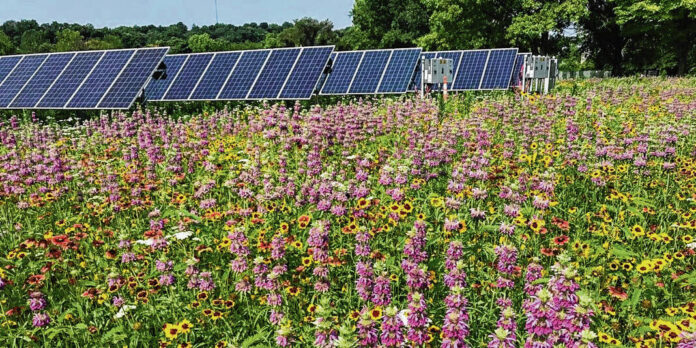
Photo provided A pollinator-friendly solar installation at the University of Dayton is similar to what developers say is planned at the proposed Swallowtail Solar Farm in northeast Bartholomew County.
After approving zoning amendments regarding solar fields in August, the Bartholomew County Plan Commission will have to reconsider an amended proposal in November.
Although the Bartholomew County Commissioners voted 2-1 last week to initially accept the plan commission recommendations, the county’s three-member executive board unanimously approved a number of changes to the original proposals on second reading Monday.
If the county commissioners make any changes, the entire matter must go back to the plan commission, according to state statutes, said Columbus/Bartholomew County Planning Director Jeff Bergman.
“The Bartholomew County Plan Commission will be given the opportunity to either agree or disagree with those changes,” Bergman said. “If they agree, the process is complete. If the plan commission does not agree, they will be given an opportunity to state their reasons for disagreement, and it will come back to the county commissioners for one more vote.”
A key term in the revisions suggested by Commissioner Tony London is the term “non-participating property,”which London defined as a neighboring property owner who does not want the solar field.
The changes approved by the commissioners are:
- Setbacks of a solar field shall be 200 feet from all non-participating property lines. No exceptions, including property separated by roads. A 200 feet setback will also be in effect for schools, churches and residential zoning districts.
- Setbacks of a solar field shall be 500 feet from all non-participating residences. No exceptions will be made unless both property owners sign a waiver.
- Equipment height shall be changed from 3 feet to 1 foot clearing from the ground.
- Variances will be allowed to be made between the property owners and the developers.
All wording regarding the size of a parcel of property would be taken out of the new regulations.
No changes were requested by the commissioners for the recommended 500 feet setback for a substation, nor for a one-half mile setback from a town’s corporate boundaries.
While the Bartholomew County Plan Commission is scheduled to meet next on Nov. 9, Bergman said the commission may schedule a separate meeting to allow adequate time for a public hearing.
One of the 30 individuals who spoke to the commissioners Monday was plan commission President Tom Finke, who cast the only “nay”vote when the proposed amendments were approved last summer.
“I would ask you to reinstate the original 500 foot setback (recommended by city/county planners),” Finke said. “If the neighbor doesn’t mind having the solar panels closer to his home, he can sign a waiver with or without compensation.”
Another opponent of using agricultural ground for solar fields was Dena Hastler.
“Columbus is considered the Athens of the Prairie, and I think thousand of acres of industrial solar fields does not fit that description,” said Hastler, who lives off County Road 450N. “Miles and miles of chair-link fences with barbed wire is going to look like (the 1994 prison film) ‘The Shawshank Redemption’ on steroids.”
The controversy and emotions stirred by by the proposed solar farm regulations has been compared to the local CAFO (concentrated animal feeding operations) issue that took place from 2015 to 2017.
Bryan Bush, who leased some land for solar fields, handed the commissioners tax assessments and sale prices that he claims indicates property values for land within a half-mile of a CAFO has gone up.
However, that claim did not sit well with one of the commissioners.
“That’s such a vague statement,” commissioner Larry Kleinhentz replied. “Everybody’s property values have gone up. A more accurate comparison would be “what has been the increase between those homes next to the CAFO and those next not next to a CAFO. That’s almost an insult of anyone’s intelligence to even listen to that argument.”
“Wasn’t the whole argument that the CAFOS were going to decrease the property value of neighboring homes?” Bush asked in response. “There was a fear that the property values would crash around the CAFOs. That fear may be found in other areas, but it hasn’t been seen in Bartholomew County. Why would property values decrease near solar farms when our local facts show those property values have not decreased around CAFOs?”
Beside local residents, there were a number of representatives of groups such as Stephanie Wells of Hoosiers For Renewables. Wells says if all proposed solar development in Indiana were placed on prime farmland, it would only take up 0.46 of the top quality agricultural property.
When the two-hour public hearing concluded, commissioners’ Chairman Carl Lienhoop seemed a little confused by the conflicting arguments.
“There’s not much agreement on the facts,” Lienhoop said. “Once in a while, you have to make a hard decision, so you have to make the best decision you can with the information you’ve got.”




